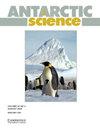乔治王岛金钟湾苔藓丰富的模式不能仅靠地质或鸟类成因来解释
IF 2
4区 地球科学
Q3 ENVIRONMENTAL SCIENCES
引用次数: 1
摘要
摘要我们着手记录金钟湾苔藓植物的多样性和分布,从而能够识别当地多样性的模式及其可能的驱动因素。结合从不同来源提取的数据和最近的收集,我们记录了63个物种的存在。苔藓物种多样性与潜在地质和鸟类成因影响的相似性分析表明,这两个因素的同源相关系数相同,为0.744。Sørensen指数<0.6,表明这些类群在记录的物种中所占比例<60%。数据显示,所选的滤层(鸟类成因土壤、非鸟类成因土壤和不同的地质提取物)并不是一致的物种分组的基础,我们得出结论,其他环境和地形因素可能是形成金钟湾苔藓群落结构的原因。为了能够有效管理1号南极特别管理区和128号南极特别保护区,有必要对当地生态系统和生物多样性进行强有力的评估,以协助《南极条约体系》规定的决策过程,该体系的基本原则之一是保护南极生态系统。本文章由计算机程序翻译,如有差异,请以英文原文为准。
Patterns of moss richness in Admiralty Bay, King George Island, cannot be explained by geological or ornithogenic drivers alone
Abstract We set out to document the diversity and distribution of bryophytes in Admiralty Bay and thereby enable the identification of patterns in local diversity and their possible drivers. Combining data extracted from different sources and recent collections, we documented the presence of 63 species. Similarity analyses of moss species diversity in relation to underlying geology and ornithogenic influence identified an identical cophenetic correlation coefficient of 0.744 for both factors. The Sørensen index was < 0.6, indicating that the groups share < 60% of the species recorded. The data showed that the selected filters (ornithogenic soils, non-ornithogenic soils and different geological extracts) did not underlie consistent species groupings, and we conclude that other environmental and topographical factors are likely to be responsible for shaping the moss community structure in Admiralty Bay. To enable effective management of Antarctic Specially Managed Area (ASMA) No. 1 and Antarctic Specially Protected Area (ASPA) No. 128, robust assessments of the local ecosystem and biodiversity are necessary to assist in the decision-making processes mandated under the Antarctic Treaty System, one of whose founding principles is the preservation of the Antarctic ecosystem.
求助全文
通过发布文献求助,成功后即可免费获取论文全文。
去求助
来源期刊

Antarctic Science
地学-地球科学综合
CiteScore
3.60
自引率
6.20%
发文量
42
审稿时长
3 months
期刊介绍:
Antarctic Science provides a truly international forum for the broad spread of studies that increasingly characterise scientific research in the Antarctic. Whilst emphasising interdisciplinary work, the journal publishes papers from environmental management to biodiversity, from volcanoes to icebergs, and from oceanography to the upper atmosphere. No other journal covers such a wide range of Antarctic scientific studies. The journal attracts papers from all countries currently undertaking Antarctic research. It publishes both review and data papers with no limits on length, two-page short notes on technical developments and recent discoveries, and book reviews. These, together with an editorial discussing broader aspects of science, provide a rich and varied mixture of items to interest researchers in all areas of science. There are no page charges, or charges for colour, to authors publishing in the Journal. One issue each year is normally devoted to a specific theme or papers from a major meeting.
 求助内容:
求助内容: 应助结果提醒方式:
应助结果提醒方式:


